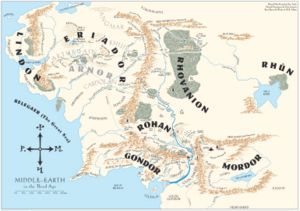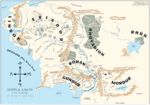Middle-Earth
 From Conservapedia
From Conservapedia Middle-earth is a fictional fantasy world invented by J. R. R. Tolkien. It is the setting of several of the stories written by him, such as The Hobbit or The Lord of the Rings. Although Middle-earth is only one continent in Tolkien's world, it is often used for the whole fictional universe and all stories Tolkien invented for it.
The world of Middle-earth is supposed to be a long gone mythological time of our earth. The continent Middle-earth corresponds roughly to the Eurasian landmass, "east of the Sea.", although the shape of the lands have changed since then.
The name "Middle-earth" was derived from Midgard,[1] the "Middle World" of Norse mythology inhabited by humans, and located underneath Asgard, home of the gods, and above Hel, the underworld.
Contents
History[edit]
Beginning[edit]
In the beginning there was Eru Ilúvatar, and from him came the Ainur. Eru created the universe, Eä. Some of the Ainur entered into Eä, as the powerful Valar and lesser Maiar, who worked a to shape the world. In the east was the continent Middle-earth, and in the west the island Valinor, land of the Valar.
First Age[edit]
In Valinor the Valar created the Two Trees, the silver Telperion and the golden Laurelin, who alternated to light the night and day; this began the First Age (of the Trees). In the time after this the Elves and Dwarves awoke in Middle-earth. The Valar invited the Elves, and some of them came to Valinor. But Morgoth and the spider Ungoliant killed the Two Trees, and stole the Silmaril jewels from the Noldor elves. From the remains of the Trees the Valar created the Sun and the Moon, which marked the begin of the second part of the First Age, the First Age of the Sun.
In the First Age of the Sun the Noldor returned to Middle-earth to retake the Silmarils and wage war against Morgoth. The still young peoples of Men arrived in the west of Middle-earth, and became involved. The Age ended when the Valar rose against Morgoth in the War of Wrath, which resulted in the final imprisonment of Morgoth and the destruction of Beleriand. The story of the First Age and the Silmarils are told in the Quenta Silmarillion.
Second Age[edit]
In the Second Age, the Maia Sauron, who had been the servant of Morgoth, rose to great power and took his master's place as the malign spirit opposed to everything good in Middle-earth. The Men who were friends to the Elves were offered the island Númenor as their new home, and many moved there. The Rings of Power were forged by the Elves and Sauron. When the King of Númenor, though Sauron's counsel, rose to make war on Valinor the shape of the world was forever changed, the island of Númenor destroyed and the road to Valinor hidden. The survivors of Númenor loyal to the West, the "Faithful" or Elendili (Quenya "Elf-friends") led by Elendil, fled to Middle-earth where they founded the realms Arnor and Gondor. High King Gil-galad of the Noldor and King Elendil of the Dúnedain formed the Last Alliance of Elves and Men to fight Sauron. At the end of the War of the Last Alliance, Sauron was defeated at the foot of Mount Doom, and his great Ring was cut from his hand by Isildur, son of Elendil. Sauron's body was slain and his vanquished spirit fled into the wilderness, which ushered in the Third Age.
Third Age[edit]
At the beginning of the Age the One Ring was lost when Isildur was killed by orcs. In the Third Age the Realms of Men went into decline after a time of prosperity, and Sauron rose to power once more. The events culminated in the War of the Ring at the end of the Age. The stories of the end of the Third Age are told in The Hobbit (T.A. 2941) and the The Lord of the Rings (T.A. 3001-3021).
Peoples[edit]
The world of Middle-earth is inhabited by many peoples and creatures. The oldest are the Elves, powerful and immortal. Next are the Dwarves, who are mortal, and great craftsmen and miners. There are also the mortal Men. Youngest of all, appearing only in the Third Age, are the Hobbits. Another people are the tree-like Ents. Although not one of the peoples of Middle-earth, there are the Orcs, made by the first Dark Lord Morgoth as his servants. The peoples of the Middle-earth world speak a variety of different languages.
Chronology[edit]
The history of the Middle-earth and the Undying Lands world spans thousands of years. Sometimes, in the wake of great historical events, a new Age is begun, again starting with the year 1.
- Creation: The period in which Arda (the world in which Middle-Earth is based in) is created by Eru.
- Ages of Lamps: The period in which the world was lighted up by gaint lamps. The age ended when Melkor distroyed the lamps.
- First Age of the Trees: An era within the Undying Lands. In this era, Trees of Valar were planted.
- Second Age of the Trees: Began with the creation of stars and ended with the destruction of the Trees of Valar.
- Age of Darkness: A time where Middle-Earth was covered in darkness.
- Age of Stars: Began with the Awakening of the Elves and the Dwarves. In this age, the Orcs were created by Morgoth.
- First Age of the Sun: (590 years): Begins with the creation of the Sun and Moon and the awakening of men. It ended with the War of Wrath, the final imprisonment of Morgoth and the destruction of Beleriand.
- Second Age of the Sun (S.A., 3441 years): Begins after the end of the War of Wrath. Contains the destruction of Númenor (T.A. 3319). Ends with the defeat of Sauron in the War of the Last Alliance.
- Third Age of the Sun: (T.A., 3021 years): Began after Sauron's defeat by the Last Alliance. Contains the events of The Hobbit (T.A. 2941) and the War of the Ring (T.A. 3018-3019). Ends with the destruction of the One Ring and the defeat of Sauron.
- Fourth Age of the Sun: followed the defeat of Sauron and the One Ring, but started officially when the Bearers of the Three Rings left for the West. The Elves dwindle and leave, while the realms of Men prosper, becoming the dominant people of Middle-earth.[2]
There exist several calendars, as the different peoples created their own or adapted them from older systems. Another important calendar for the books is that of the Hobbits: the Shire Calendar and the Shire Reckoning. The Shire Reckoning (S.R.) starts with the colonisation of the Shire in T.A. 1601 as year one. The Shire Calendar and Shire Reckoning was used in the Shire and in Breeland.[3]
References[edit]
- ↑ http://www.pantheon.org/areas/mythology/europe/norse/articles.html
- ↑ J. R. R. Tolkien, The Lord of the Rings, Appendix B
- ↑ J. R. R. Tolkien, The Lord of the Rings, Appendix D
See also[edit]
- Category:Middle-earth, Lists of Middle-earth entries
- Middle-earth locations, Middle-earth objects
- Tolkien's languages and scripts
| ||||||||||||||||
Categories: [Middle-earth]
↧ Download as ZWI file | Last modified: 02/26/2023 04:39:53 | 12 views
☰ Source: https://www.conservapedia.com/Middle-earth | License: CC BY-SA 3.0
 ZWI signed:
ZWI signed:

 KSF
KSF